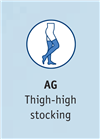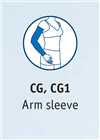 How does graduated compression therapy help with the management of venous problems?
How does graduated compression therapy help with the management of venous problems?
How does graduated compression therapy help with the management of venous problems? As a person walks, the contraction and relaxation of the calf muscles around the veins aid in moving blood toward the heart. The external graduated compression of SIGVARIS socks and stockings act as a layer of muscle by gently squeezing the stretched vein walls together, allowing the valves to close. The cavity of the vein is reduced, thereby restoring blood flow to a normal state and aiding overall circulation.
To be most effective, the socks or stockings should be put on at the start of your day and removed before you go to bed. Some people have an inherited weakness of the vein walls or valves which creates additional challenges to venous return. Wearing SIGVARIS graduated compression socks or stockings is vital for the prevention and treatment of varicose veins and other circulatory problems.
Anti-Embolism vs. Medical Compression Stockings
The biggest difference between Anti-Embolism Stockings and Medical Compression Stockings is the compression level and the medical reason for which it is worn. Anti- Embolism Stockings are usually 8–18mmHg, while medical compression stockings are a medically-measured 15–20mmHg or higher. In addition, the purpose of anti-embolism stockings is to maintain normal venous return in a bedridden patient.
SIGVARIS MEDICAL Compression Hosiery and Socks are used to treat venous and lymphatic disorders in ambulatory patients. Graduated compression stockings are used for all stages of Chronic Venous Insufficiency, including varicose veins, edema, stasis skin changes and venous procedures. They may also be used in preventing and treating Post-Thrombotic Syndrome. According to medical research, ambulatory patients with Chronic Venous Disorders require more compression than is available in anti-embolism stockings.
A Simple Rule of Thumb:
If the patient is laying in the bed = anti-embolism stockings
If the patient is ambulatory = medical graduated compression stockings











